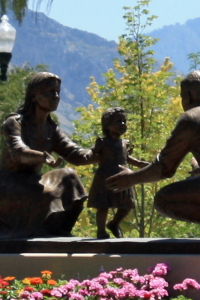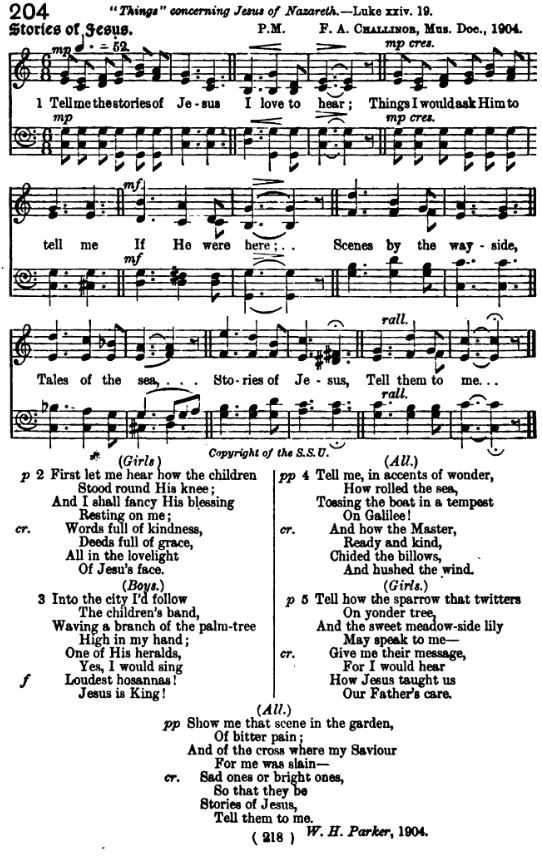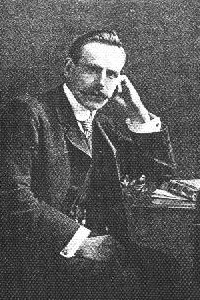
Tell Me the Stories of Jesus
Hymn of the Month
Hymn Info ~ Author ~ Composer

 Most people would agree that young children and story time go together like peanut butter and jelly. Scientific studies have shown that when parents and children cuddle up together to read stories they improve their emotional bonds, reduce their stress levels and boost the child's brain development. Hearing the same story over and over again has been shown to be important for learning language and logic skills. Stories help children to understand things they do not experience in their everyday routine. This is true for teenagers and adults as well. Stories about family and ancestors can help develop a sense of personal identity. Stories about the founding of our country can help develop a sense of national identify and patriotism. Stories with analogies can help with understanding of religious concepts like faith.
Most people would agree that young children and story time go together like peanut butter and jelly. Scientific studies have shown that when parents and children cuddle up together to read stories they improve their emotional bonds, reduce their stress levels and boost the child's brain development. Hearing the same story over and over again has been shown to be important for learning language and logic skills. Stories help children to understand things they do not experience in their everyday routine. This is true for teenagers and adults as well. Stories about family and ancestors can help develop a sense of personal identity. Stories about the founding of our country can help develop a sense of national identify and patriotism. Stories with analogies can help with understanding of religious concepts like faith.
Some of the greatest stories ever told for the instruction of the listeners are the parables that Jesus Christ, the Master Teacher, gave the people as recorded in the New Testament. Everyday objects and situations familiar to the listeners were used to teach people how they should live and what they should believe. Stories relating examples of personal conduct in the face of difficulties are found throughout literary classics. The Bible is the foremost literary classic and leads the way with the accounts given of the life of Christ . These are stories of utmost significance and children learn them in homes and Sunday Schools around the world.
The text of "Tell Me the Stories of Jesus," describes in poetic imagery just such a teaching scene. The text is written as the voice of a child asking to be told again their favorite stories about Jesus. It is obvious that the child has heard these stories before, as there is mention of particular events. The second verse mentions Jesus blessing the children, while another verse gives details of the account of Jesus calming the sea. Descriptive words are woven into the text that paints a verbal picture of the characteristics of Christ. The second phrase of the first verse gives everyone significant food for thought. What would be the "things I would ask Him to tell me if He were here"?
The inspiration for "Tell Me the Stories of Jesus" is said to have come from a Sunday School Class at the Chelsea Street Baptist Church in Nottingham, England, about 1885. The author, William H. Parker, is understood to have been a teacher there who received repeated requests from the children for another story. It seems apparent that he was a good storyteller. He was also a good writer known for writing hymns and songs for Sunday-School anniversaries. It is believed that "Tell Me the Stories of Jesus" may have been one of those anniversary songs. A tune was written for it about 1904 by Frederick A. Challinor and submitted to a competition sponsored by a national Sunday School Union. While the style of the flowing tune is not a traditional hymn or gospel song, with the text the overall effect qualifies it to be included alongside other hymns. It was apparently well received. The completed song titled "Stories of Jesus" appeared in the 1905 edition of "The Sunday School Hymnary" published by that Sunday School Union in London, England, along with fifteen other hymns by Mr. Parker. See image below as digitized by Google and found at archive.org.

As seen in the image, the text originally contained six verses. Editors of subsequent hymnals have omitted some verses and made some changes to the text over the years.
The text as found in the 1905 publication:
Stories of Jesus
1. Tell me the stories of Jesus
love to hear;
Things I would ask Him to tell me
If He were here:
Scenes by the wayside,
Tales of the sea,
Stories of Jesus,
Tell them to me.
2. First let me hear how the children
Stood round His knee;
And I shall fancy His blessing
Resting on me;
Words full of kindness,
Deeds full of grace,
All in the lovelight
Of Jesu's face.
3. Into the city I'd follow
The children's band,
Waving a branch of the palm-tree
High in my hand;
One of His heralds,
Yes, I would sing
Loudest Hosannas!
Jesus is King!
4. Tell me, in accents of wonder,
How rolled the sea,
Tossing the boat in a tempest
On Galilee!
And how the Master,
Ready and kind,
Chided the billows,
And hushed the wind.
5. Tell how the sparrow that twitters
On yonder tree,
And the sweet meadow-side lily
May speak to me -
Give me their message,
For I would hear
How Jesus taught us
Our Father's care.
6. Show me that scene in the garden,
Of bitter pain;
And of the cross where my Saviour
For me was slain -
Sad ones or bright ones,
So that they be
Stories of Jesus,
Tell them to me.
The use of "Tell Me the Stories of Jesus" spread to other hymnals and it has been found in over a hundred Sunday-School collections and hymnals of different denominations, according to hymnary.org.
It appeared in "Sing With Me," the children's songbook of The Church of Jesus Christ of Latter-day Saints, (LDS), published in 1969 at Salt Lake City, Utah. This version included the first four verses as originally published with the exception of using "Jesus'" instead of "Jesu's" in the second verse. The song with the first, second, and fourth verses continued into the 1989 LDS "Children's Songbook" with a few more changes to the second verse to modernize the text. The music was transposed to a slightly lower key.
A beautiful message for children and adults alike, this hymn reminds us that our Savior requires us to be as children, and we need to hear the stories of Jesus again, and again.


William Henry Parker was born in March of 1845 at Basford, England. Basford is a northern suburb of Nottingham that was originally a separate parish.
It is likely that he is the same William Parker listed in the 1851, 1861 and 1871 census records as the son of James M. and Hellen S. Parker. It is said that he worked building machinery at a lace factory in his early career. The census record shows William at the age of 16 occupied as a blacksmith apprentice, and at age 26 as a machine builder. The lace industry in Nottingham employed many people at that time. Later in life, he is reported to have changed careers, and was said to be the head of an insurance company.
Although apprenticed to a trade in his youth, it is apparent that he also received an education and had literary interests. He was reported to have begun writing verses early in life. As mentioned previously, he was a member of the Chelsea Street Baptist Church where he was involved in the Sunday School. It is likely that his Pastor encouraged his writing of hymns for Sunday School Anniversaries, and they were said to have first been printed on sheets for those occasions. They were later included in hymn collections. His Pastor included three hymns in "The School Hymnal" in 1880, and as mentioned above, fifteen were included in the 1905 edition of "The Sunday School Hymnary."
William served as the superintendent of the Chelsea Street Baptist Sunday School and as church secretary for thirty-five years. It is said that he wrote an annual hymn for thirty of those years. He was a poet as well as a hymnist, and in 1882 , at the age of thirty-seven, published a small volume of poetry titled, "The Princess Alice and other poems." This was likely dedicated to the real Princess Alice, daughter of Queen Victoria and Prince Albert, and it is said that a copy of the book was gratefully received by the Queen.
William Parker's life of service came to a close in December of 1929, at the age of eighty-four. He died in the same area where he was born, Basford, Nottinghamshire, England. Although he spent his life in one small geographic locale, his hymns of faith have traveled around the world and continue his legacy of service.

Tell Me the Stories of Jesus
Text as found in the 1989 Children's Songbook
Tell me the stories of Jesus I love to hear,
Things I would ask him to tell me if he were here.
Scenes by the wayside, tales of the sea,
Stories of Jesus, tell them to me.
Oh, let me hear how the children stood round his knee.
I shall imagine his blessings resting on me;
Words full of kindness, deeds full of grace,
All in the lovelight of Jesus' face.
Tell me, in accents of wonder, how rolled the sea,
Tossing the boat in a tempest on Galilee!
And how the Master, ready and kind,
Chided the billows and hushed the wind.

 Frederick Arthur Challinor was born in November of 1866 at Longton, Staffordshire, England. Longton is about 45 miles south of Manchester.
Frederick Arthur Challinor was born in November of 1866 at Longton, Staffordshire, England. Longton is about 45 miles south of Manchester.
Longton is the southernmost of the towns in the borough of Stoke-Upon-Trent known as 'The Potteries.' It was known for manufacture of English porcelain. Josiah Wedgwood owned factories in other nearby towns.
Beside the potteries, other employment was in coalmines, brick making, and iron-works. Frederick's father is said to have been a coal-miner. At that time, education was not required for all children and it was customary among the poorer people for children to work to help support their families. At the age of ten, it is reported that young Frederick began labor in a brickworks. After two years, he began working at a colliery or coalmine. At the age of fifteen, he began work at a pottery. It is understood that a musical co-worker there, and the family's inheritance of a piano changed the course of his life.
Frederick studied music and took instruction from his co-worker during his meal breaks at the factory. He took lessons whenever he could afford it, and studied from books. While working full time he eventually passed the Diploma examination and became an Associate of the Royal College of Music. He persevered through challenges and earned his bachelor's degree in 1897 at the age of thirty-one. He continued and by the time he earned his doctorate in 1903 it is reported that he had composed and published over 400 works including three cantatas.
Frederick also had a family during this time. His wife, Annie, was also from Longton according to the 1901 census, and they had several children. His occupation was listed in the census as 'teacher of music.'
Frederick apparently did not forget his roots and it is said that he wrote music for people living in hard times. Tunes for Sunday School anniversaries were part of this work.
Frederick Challinor passed away, at the age of eighty-five, in June of 1952 at the southern seaside town of Paignton, Devon, England. It seems likely that he had retired there as he was buried in a nearby town. Fortunately for us, his music lives on and continues to lift those in hard times.

Information for this article came from:
Children’s Songbook of The Church of Jesus Christ of Latter-day Saints, (The Church of Jesus Christ of Latter-day Saints, Salt Lake City, Utah, 1989, p. 57)
"Sing With Me - Songs for Children", (Deseret Book Company for The Church of Jesus Christ of Latter-day Saints, Salt Lake City, Utah, 1980, p. B-46)
'Holy Bible, King James Version,' Matthew 4:23-24, p. 1192; Mark 10:13-16, p. 1258-59; Luke 8:22-25, p. 1289. (The Church of Jesus Christ of Latter-day Saints, Salt Lake City, Utah, 1979)
Webster’s New Collegiate Dictionary, (G & C Merriam Company, Springfield, Massachusetts, 1975)
"England and Wales Census, 1901," database, FamilySearch (https://familysearch.org/ark:/61903/1:1:XSQT-K6Z : 29 August 2015), Frederick A Challinor, Lonton, Staffordshire, England; from "1901 England, Scotland and Wales census," database and images, findmypast (http://www.findmypast.com : n.d.); citing Longton subdistrict, PRO RG 13, The National Archives, Kew, Surrey. http://www.thepotteries.org/six_towns/longton.htm
